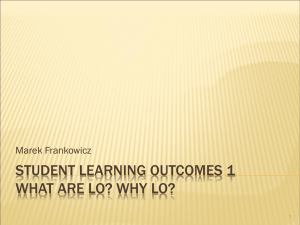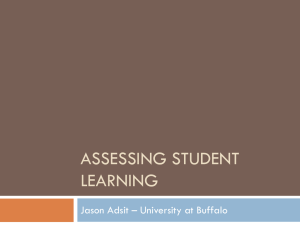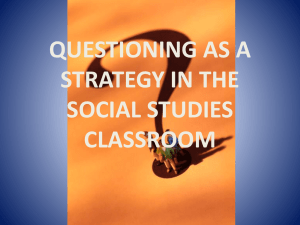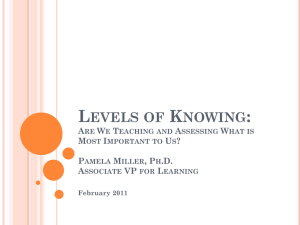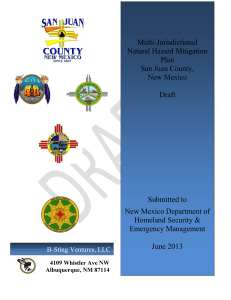CURRICULUM 101 - San Juan College
advertisement
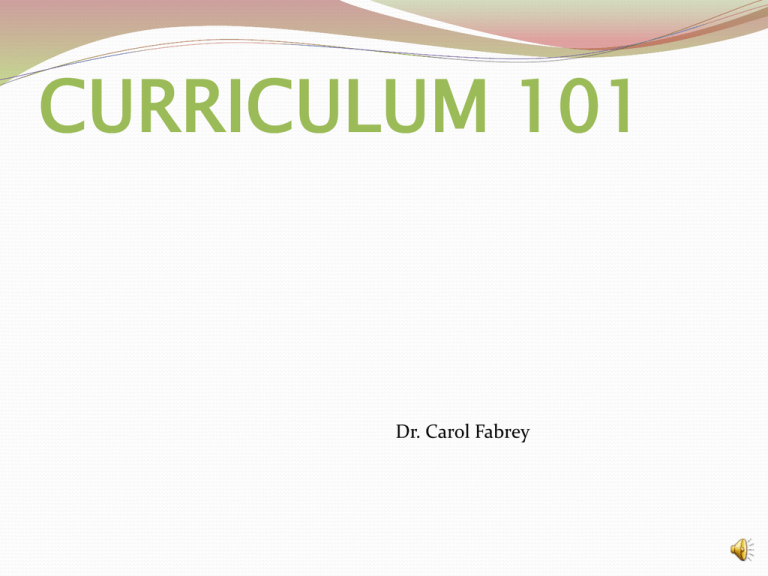
CURRICULUM 101 Dr. Carol Fabrey AGENDA Tasks: Welcome Define CURRICULUM Introductions Rank Employment Skills KWL Chart PPT for your program Develop Educational Goals and Learning Outcomes for your program A starting point… How do we define curriculum? How Do We Define Curriculum? Curriculum is that which is taught at school. Curriculum is a set of subjects. Curriculum is content. Curriculum is a sequence of courses. Curriculum is a set of performance objectives. How Do We Define Curriculum? Curriculum is all planned learning for which the school is responsible. Curriculum is all the experiences learners have under the guidance of the school. John Delnay (1959) How Do We Define Curriculum? The most common definition derived from the word (Latin root), means “racecourse.” “ For many students, the school curriculum is a race to be run, a series of obstacles or hurdles (subjects) to be passed.” Bandi and Wales, 2005 Multiple Definitions • All the learning which is planned and guided by the school, whether it is carried on in groups or individually, inside or outside the school, whether it is carried on in groups or individually, inside or outside the school. (John Kerr, as quoted in A. Kelly 1999) • Anything and everything that teaches a lesson, planned or otherwise. (Leslie Wilson, 2005) • What is taught in school or what is intended to be learned. Curriculum represents a set of intentions; a set of intended learning outcomes. (Posner & Rudnitsky, 1986) Before developing YOUR definition… Review the various types of curricula… Handout: Types of Curricula Types of Curricula OVERT, EXPLICIT, OR WRITTEN CURRICULUM Refers to documents, texts, resources, and supportive teaching materials that are overtly chosen to support the intentional instructional agenda of a school. SOCIETAL CURRICULUM The ongoing, informal curriculum of family, peer groups, neighborhoods, church organizations, occupations, mass media and other socializing forces that ‘educate’ all of us throughout our lives. Types of Curricula HIDDEN OR COVERT CURRICULUM The kinds of learning derived from the very nature and organizational design of the learning institution, as well as from behaviors and attitudes of instructors and administrators which may include both positive or negative messages. We learn simply by the exposure of living. Much that passes for education is not education at all but ritual. That fact is that we are being educated when we know it least. Gardner Types of Curricula NULL CURRICULUM Since it is impossible to teach everything, many topics and subject areas must be intentionally excluded from the written curriculum. Eisner (1994) indicates that when certain subjects or topics are left out of the overt curriculum, messages are sent to students that certain content and processes are not important enough to study. Types of Curricula PHANTOM CURRICULUM The messages prevalent in and through exposure to any type of media. CONCOMITANT CURRICULUM What is taught or emphasized at home, or those experiences that are a part of a family’s experiences, or related experiences sanctioned by the family. Types of Curricula RHETORICAL CURRICULUM Comprised of ideas offered by policymakers, school officials, administrators or politicians. May also come from publicized works offering updates in pedagogical knowledge. CURRICULUM-IN-USE The actual curriculum that is delivered and presented by each instructor. Types of Curricula RECEIVED CURRICULUM Those things that students actually take out of the classroom; concepts and content that are truly learned and remembered. INTERNAL CURRICULUM Processes, content, knowledge combined with the experiences and realities of the learner to create new knowledge. ELECTRONIC CURRICULUM Information learned through searching the Internet or through using e-forms of communication. Broad Definition Is Curriculum… Scope and sequence? The study of any and all educational phenomena? The experiences or activities that engender these experiences? What is intended to be learned? A course of study in one subject at a school or college? All the courses of study offered by an educational institution? Broad Definition Is CURRICULUM… An integrated course of academic studies? Any program or plan of activities? A group of related courses, often in a special field of study? A set of subject matter, planned or unplanned, implemented by the academic institution, to meet general and specific needs of students in order to prepare them for their future roles? Schooling? Your Turn Define CURRICULUM Next Consideration… What must be considered in making curriculum decisions? Factors Influencing Curriculum Decisions 1. The nature of the learner 2. The nature of society 3. The nature of the subject matter Factors Influence on Educational Goals and Learning Outcomes NATURE OF SOCIETY AND ITS NEEDS NATURE OF SUBJECT MATTER AND ITS IMPORTANCE NATURE OF THE LEARNER (HIS/HER NEEDS) STATEMENT OF EDUCATIONAL GOALS AND LEARNING OUTCOMES Who is the Learner? Who are the learners at San Juan College? What is the Nature of our Society and its Needs? What are employers looking for in our San Juan College graduates? Rank Employment Skills for your program Handout: Skills Sought by Employers Chart The Importance of the Subject Matter? What is the nature of the subject matter taught at San Juan College? How important is the subject matter taught at San Juan College? A Curriculum that Enables Learners to… • Linger longer • Dig deeper • Cross boundaries to secure learning to follow through to recap to reach conceptual understanding go beneath the surface link subjects apply to real world situations A Curriculum for Society • For the 21st century for our changing society economy technology • Adaptable • Challenging for different needs expands horizons real audiences real purposes real skills A Curriculum Emphasizing the Importance of the Subject Matter A curriculum that supports: • the learner and the quality of the learning experience and learning environment • relevance and real-world issues • affective and hands-on learning as well as cognitive thinking • critical and systemic thinking rather than only informational learning Much More… A curriculum that is more than the sum of its parts… Coherent…building on and able to build upon, not repetitive Meaningful for all students…Why am I doing this? How can I use this? Utilizes resources…supports learning objectives through instructor expertise Educational Goals What are our EDUCATIONAL GOALS at San Juan College? How can we define our Educational Goals? What are your Learning Outcomes? SJC Mission/Vision Statement (Draft) To inspire and support the pursuit of knowledge and the achievement of personal and community goals through quality education and services. SJC is recognized as a progressive, dynamic learning environment built on mutual respect, meaningful participation and a collective commitment to the core values of the college and the community. Handout: SJC Mission/Vision Statement and CSLO’s San Juan College Common Student Learning Outcomes Upon completion of San Juan College programs and degrees, the student will… Learn………Students will actively and independently acquire, apply and adapt skills and knowledge to develop expertise and a broader understanding of the world as lifelong learners. Think……….Students will think analytically and creatively to explore ideas, make connections, draw conclusions, and solve problems. Communicate………Students will exchange ideas and information with clarity and originality in multiple contexts. Integrate…..Students will demonstrate proficiency in the use of technologies in the broadest sense related to their field of study. Act.....Students will purposefully, reflectively, and respectfully in diverse and complex environments. (Handout) http://www.sanjuancollege.edu/documents/FSPDocuments/AssessmentCommittee/downloads/CSLO%20Rubrics.pdf Learning Outcomes - Defined Learning Outcomes specify the observable and/or measurable knowledge, skills and judgment which a person is expected to have developed or acquired as the result of a course of study or a set of identifiable experiences. Learning Outcomes describe what a person should know or be able to do or demonstrate at a given point in his/her development. Learning Outcomes: • are broad • use plain language • use verbs requiring verifiable performances Bloom’s Taxonomy Bloom’s Taxonomy is a multi-tiered model of classifying thinking according to six cognitive levels of complexity Levels of Knowing – Bloom’s Taxonomy Bloom’s Taxonomy is a multi-tiered model of classifying thinking according to six cognitive levels of complexity The levels, often depicted as a stairway, direct many teachers to encourage students to ‘climb to a higher level of thought’ The taxonomy is hierarchical, each level subsumed by the higher levels This hierarchical arrangement leads to natural divisions of lower and higher level thinking The taxonomy is frequently used when writing learning outcomes to describe the cognitive level that is expected in student work Handout: Bloom’s Taxonomy “Revised” For example… Samples… SJC Associate of Applied Science -Business Administration and the Associate of Arts – Business Administration (Draft) Program Learning Outcomes: The student will demonstrate understanding and application of general business concepts in the American and global free market system. The student will demonstrate understanding and application of basic Management Principles and Organization Practices in modern business. The student will demonstrate understanding and application of common Marketing Principles and concepts. The student will demonstrate understanding and application of General Accounting as it pertains to business decisions. The student will demonstrate understanding and application of the Management of Human Resources concepts and principles and identify how these principles affect the relationship between employers and employees. The student will demonstrate understanding and application of the Communication and Group Interaction skills necessary for a business career. Samples… SJC Occupational Safety On-line AAS Degree – School of Energy (Draft) The student will be able to: • Appraise and control occupational safety, health and environmental hazards that may exist in the workplace. • Understand and apply various federal regulations pertaining to safety issues, as well as voluntary industry best practices. • Effectively communicate safety issues at all levels of an organization. • Promote and promulgate appropriate safety training for all levels of an organization. • Provide top management with appropriate cost analysis and budgeting information for an effective safety program. Samples of Program Learning Outcomes Paralegal Studies, AS The successful graduate will: Understand the United State judicial system, the jurisdiction of all its courts, and the relationship of the courts to one another and demonstrate this understanding. Demonstrate the correct application of legal vocabulary and the court rules in a number of substantive legal fields. Create a number of written assignments that consist of documents frequently utilized in legal settings and the use of several software programs developed for and used in courts and law offices. Analyze fact situations in order to conduct legal research (utilizing print materials, as well as computer assisted research) and draft legal documents based on that research as demonstrated. Demonstrate the ability to apply the Code of Professional Responsibility to a number of situations commonly occurring in legal settings and recommend an ethical course of conduct. Have experience doing substantive legal work in a legal setting under the supervision of a lawyer. Green – Knowledge, Blue – Skills, Red - Judgment Accounting ABA The successful graduate will: Analyze accounting issues; research and evaluate alternatives; then formulate and communicate an ethical solution. Assess risk, evaluate the internal control structure, and design and implement an audit plan. Analyze business transactions, problem solve, and apply Generally Accepted Accounting Principles (GAAP) to make reporting decisions as demonstrated. Identify and research a global accounting issue through the successful completion of a prescribed research paper. Understand and employ current technology, especially spreadsheet applications. Compare and contrast the stances between the various regulatory bodies. Identify and analyze various business transactions from accounting and tax aspects. Your Turn… WHAT ARE THE EDUCATIONAL GOALS AND LEARNING OUTCOMES FOR YOUR PROGRAM? Questions to consider… WHAT ARE THE EDUCATIONAL GOALS FOR YOUR PROGRAM? How do you know these are appropriate ? WHAT ARE YOUR SPECIFIC LEARNING OUTCOMES? How do you know these are appropriate ?

